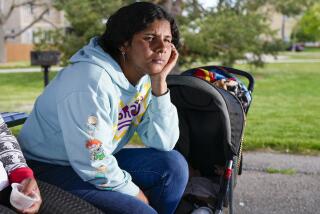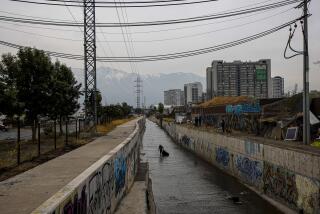Banking on the Poor : AID Program Reaches Out in Third World
- Share via
LA PAZ, Bolivia — Juana Choque, a 39-year-old woman who migrated to La Paz from rural Bolivia, recently got the first bank loan of her life, $100 to expand her sidewalk vending business.
“I want to become a big businesswoman, like the other senoras ,” said Choque with a gleam in her eye. In a country where annual income averages $800, the loan could go a long way toward helping Choque expand her inventory of fresh vegetables, even enable her to rent a second sentaje, or vending site.
Choque is one of 4,000 poor Bolivian women who have received loans from Pro Mujer, a La Paz-based communal bank sponsored by the Agency for International Development, the U.S. government’s foreign aid arm.
She is not just a client but a sitting member of the bank’s loan committee, as are 40 other women who meet once a week in a dusty building in El Alto, a windblown squatter’s village above La Paz. All are poverty-stricken, and many are heads of households with four or more children. Lacking financial histories or property, they would not be credit-worthy by conventional standards.
Pro Mujer is part of a renewed emphasis on the part of the Clinton Administration’s State Department on “micro-enterprise” lending, a bottom-up philosophy of foreign aid that officials hope can make entrepreneurs of the “poorest of the poor” in Latin America and elsewhere.
Such loans will grow to $200 million next year, double the amount in 1993--despite a 20% drop in the agency’s overall aid budget to $6.3 billion.
The 25 or so micro-enterprise credit operations funded by the Agency for International Development range from the tiny Pro Mujer to the huge Grameen Bank of Bangladesh and Bank Rakyat Indonesia, each with more than a million members. Another is Banco Sol of Bolivia, which accommodates borrowers who have progressed beyond Pro Mujer membership to qualify for commercial loans of up to $1,000.
The success of such overseas programs for the poor has given rise to some 200 micro-enterprise loan programs in the United States, including several in Southern California, funded by various public and private sources. The founders of Microenterprise Loan Program of Orange County in Garden Grove, for example, patterned their program directly after the Grameen Bank in Bangladesh.
Accion International, a Cambridge, Mass.-based organizer of 20 micro-enterprise loan programs in 14 Latin American countries, including Banco Sol, has started up small loan programs in five U.S. cities, including San Diego. Credit programs in Pomona and Westminster directed toward credit-needy women and Vietnamese immigrants, respectively, are up and running.
“The Administration is particularly impressed with these programs as a way to get at really poor people and to allow them to participate in the country’s economic and financial systems,” said Richard Rosenberg, AID’s associate assistant administrator. “We’re seeing excellent repayment rates and . . . basically a new financial technology emerging.”
Micro-enterprise loan programs are also viewed as a modest compensation of the urban poor for the effects of the “privatization” process under way in many countries, including Bolivia. It has cost tens of thousands of poor people their jobs as governments have cut back “make-work” employment at state-run businesses and utilities, said Shane Hunt, a Boston University economics professor now on leave to advise the Peruvian government.
But the rise in AID’s micro-enterprise funding has also reopened a debate on the efficacy of the programs, nearly all of which depend on huge subsidies. Critics, including Ohio State University economics professor Dale Adams, say many loan programs are ineptly run, disbanding once outside funding sources dry up and leaving borrowers out in the cold.
In any case, the government’s funding of poor people’s credit programs in Latin America and elsewhere represents a real departure from past policy. Previously, the government tried to help the foreign poor mainly by providing business education and technical advice to various export-based industry groups, figuring that jobs would trickle down to the working class.
Those programs still exist, but the Clinton Administration has mandated a more grass-roots approach by making credit available directly to poor people such as Choque, who ordinarily would never qualify for a loan. Communal banks such as Pro Mujer--administered by AID-approved managers--are preferred vehicles for delivering those loans.
Choque and most of the other bank members run tiny vending stands that clog the streets of La Paz. She is typical of a huge portion of Bolivia’s work force, half of whom are self-employed and recently arrived from the countryside. She and other street vendors sell everything from cosmetics and cooked food to used auto parts and contraband.
Pro Mujer is hardly a bank in the traditional sense, lacking a charter and regulatory supervision. And it is far from self-sufficient, relying on outside funds that next year will total $500,000. In addition to U.S. government funds, the program receives money from Catholic Relief Services and other private sources.
But the women have proven excellent credit risks: less than 1% of loans have gone unpaid since the bank was founded three years ago. The women pay back the loans--which range from $50 to $400--in four months at 12% annual interest. They also agree to a compulsory savings program, setting aside up to 20% of their loans in deposits that become the bank’s equity. Members don’t need a business to qualify for a loan, just a business plan .
“The important and unusual contribution of Pro Mujer is that it takes very poor women, gives them financial services and training, and makes it possible for them to enter the commercial micro-finance sector,” said Marguerite Robinson, a fellow at the Harvard Institute for International Development and a consultant to the big Indonesia communal bank.
“This helps the women and their families both in improving their income and in increasing their sense of empowerment in their society,” Robinson said.
Before receiving the loans, Choque and the others get financial management lessons. Afterward, they continue to get advice from Pro Mujer administrators on family planning, child psychology and “empowerment”--how to assert their rights and obtain government services in a country where women are second-class citizens.
“I was a coward to talk but now I have found that I can express myself,” Choque said. “I was mute. Now I’m more sociable.”
Pro Mujer director Lynne Patterson, a former New York City schoolteacher, said the project’s long-term viability will depend on whether it can become self sufficient, like a real bank, which she believes it can in three years if it keeps growing in loans and customers. “If we can double in size by 1998, we won’t need any outside money,” she said.
That kind of goal is well advised, said Ohio State’s Adams, who has studied financial problems of developing countries for 30 years. He said the history of micro-enterprise loan programs is dotted with major failures in such countries as Uganda and Guatemala.
“Most altruistic credit programs die out not long after donors lose patience in subsidizing them,” Adams said. “There are some exceptional programs, but there are a lot that are extremely costly and they are very subsidy-dependent. Most never resolve the fundamental problem of recovering their costs and end up having to drop their services.”
J. D. Von Pischke, a KMPG Peat Marwick consultant in Washington who provides technical assistance for financial sector development in developing countries worldwide, said micro-enterprise programs should be judged not simply by whether they are profitable, but whether their social and economic benefits are worth the cost.
“The positive aspects are that, clearly, large numbers of people who need credit are being reached, and this is in itself a good thing. The question is, at what cost? If that cost was $10 per each woman that was reached, I suspect that’s acceptable. Maybe the cost is not acceptable at $100.”
Pro Mujer at a Glance
* What: Pro Mujer (Spanish for “Pro Women” is a micro-enterprise program for poor women in La Paz, Bolivia, that makes business loans of $50 to $400. The loans are paid back are paid in four months at 12% and the borrowers agree to set aside up to 20% of the loans as savings. The borrowers also serve as the bank’s loan committee. The program also offers financial training.
* Who: The borrowers are typically indigenous women who migrated to La Paz from the countryside and are heads of households. Most are street vendors who use the money to expand inventory or to buy equipment. About 1,500 women are clients of some 46 Pro Mujer-sponsored banks averaging 30 women each in La Paz. Pro Mujer is now expanding to other Bolivian cities.
* How: About half of Pro Mujer’s $500,000 annual budget comes from the U.S. Agency for International Development, the other half from private sources including Catholic Relief Services. The communal bank hopes to be self-sufficient by 1998.
* Where: Pro Mujer is based in La Paz, but there are several hundred micro-enterprise loan programs in 25 countries seeking to make entrepreneurs of the poor by giving them access to commerical banking services. About 200 are in the United States, including several in Southern California.
More to Read
Sign up for Essential California
The most important California stories and recommendations in your inbox every morning.
You may occasionally receive promotional content from the Los Angeles Times.













